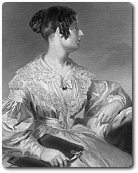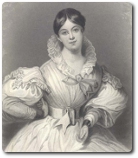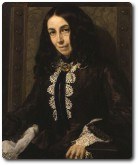Christina Rossetti, selected poems Contents
Victorian women's poetry
Critical reception
Victorian women's poetry has only become a subject of serious study in the past twenty years. This is perhaps because early nineteenth-century female poets such as Letitia Landon and Felicia Hemans often positioned themselves apart from their male contemporaries. They were seen by early critics to be the creators of a particularly feminine poetic tradition, which was characterised by discourses on love, children, families and cultivated nature.
Felicia Hemans (1793-1835)
 Hemans was a highly popular and well-regarded poet in the Victorian period. She published her first book of poetry when she was only 14 and she continued to write prolifically, publishing eighteen more during the course of her life. Like Rossetti, she was an invalid for much of her life. However, she also had six children to care for and financially support, after separating from her husband after only seven years of marriage.
Hemans was a highly popular and well-regarded poet in the Victorian period. She published her first book of poetry when she was only 14 and she continued to write prolifically, publishing eighteen more during the course of her life. Like Rossetti, she was an invalid for much of her life. However, she also had six children to care for and financially support, after separating from her husband after only seven years of marriage.
In many of her poems, Hemans addresses concerns relevant to the women of her time such as marriage, grief, motherhood and romantic and spiritual love. Her major collections include:
- The Forest Sanctuary (1825)
- Records of Woman (1830)
- Songs of the Affections (1830).
In Records of Women, she focuses on heroines from all over the world. From Joan of Arc to an unknown Indian woman, she celebrates the courage, passion and love of particular females.
In 1856, Rossetti's brother, William Michael, edited a volume of Hemans' poetry, entitled The Poetical Works of Mrs. Felicia Hemans. He introduced her poetry with praise. However, underlying his praise was a distinction between how male and female poetry was judged. He speaks of the tone of her mind as ‘feminine in an intense degree' (read William Michael's Prefatory Notice).
Letitia Elizabeth Landon (1802-1838)
 Landon, or L.E.L. as she is commonly known, began publishing her poetry at the age of 18 and soon attracted recognition, becoming one of the most popular female poets of the nineteenth century. Throughout the 1820s and 30s, she wrote numerous poems and several novels. She contributed many to magazines and literary annuals. Between 1832 and 1839, she edited the Fishers' Drawing Room Scrapbook. This was a hugely popular, decorative volume of poetry and engravings. As her success grew, she published several volumes of poetry. Her long narrative poems, including The Improvisatrice, The Troubadour and The Golden Violet, received much acclaim and recognition.
Landon, or L.E.L. as she is commonly known, began publishing her poetry at the age of 18 and soon attracted recognition, becoming one of the most popular female poets of the nineteenth century. Throughout the 1820s and 30s, she wrote numerous poems and several novels. She contributed many to magazines and literary annuals. Between 1832 and 1839, she edited the Fishers' Drawing Room Scrapbook. This was a hugely popular, decorative volume of poetry and engravings. As her success grew, she published several volumes of poetry. Her long narrative poems, including The Improvisatrice, The Troubadour and The Golden Violet, received much acclaim and recognition.
L.E.L'.s increasing celebrity status caused an intensification of interest in her private life. In 1838, to escape scandal, she married a governor of the Gold Coast renowned for his cruelty. Three months after arriving in Africa with her new husband she was found dead with a bottle of prussic acid in her hand. She was only 36. Suspicions were aroused and a huge amount of speculation about the causes of her death followed.
L.E.L'.s writings were a huge influence on the composition of Rossetti's own poetry. Many of her poems are concerned with exploring the difficulties faced by the female artist and discuss the issue of the woman and fame.
Elizabeth Barrett Browning (1806-1861)
 Rossetti acknowledges Barrett Browning as a significant influence on her own poetry in her 1881 sonnet sequence Monna Innominata. In the preface to this sequence, she speaks of her as ‘the Great Poetess'. At one time, Rossetti was even contemplating writing a biography of Barrett Browning, but her plans were halted by the fact that Browning's husband poet Robert Browning, voiced his objection to any biography of his wife.
Rossetti acknowledges Barrett Browning as a significant influence on her own poetry in her 1881 sonnet sequence Monna Innominata. In the preface to this sequence, she speaks of her as ‘the Great Poetess'. At one time, Rossetti was even contemplating writing a biography of Barrett Browning, but her plans were halted by the fact that Browning's husband poet Robert Browning, voiced his objection to any biography of his wife.
Like Hemans and Landon, Barrett Browning was an intensely intellectual child. By the age of twelve, she had written an epic poem consisting of four books of rhyming couplets. She also learned Latin, Greek and Hebrew at a young age and read classical texts in their original languages. At the age of 20, Barrett Browning became seriously ill and spent the rest of her life as an invalid battling with various symptoms.
Barrett Browning's most significant works include:
- Sonnets of the Portuguese which she published in 1850
- Aurora Leigh which she published in 1856.
Aurora Leigh is a verse novel in which ideas about women, society, art and God are developed. Set in both contemporary Italy and England it discusses the problems that beset nineteenth century men and women.
Female community
Rossetti participates in a kind of female poetic community when she associates herself with Felicia Hemans, L.E.L. and Elizabeth Barrett Browning, by working with the same themes and addressing them directly in her poetry.
In the 1860s, Rossetti made some literary contacts through her membership of the Portfolio Society. Rather than attend meetings regularly, she corresponded with the others in the group through letters. Themes were often set for writing poetry and Rossetti participated by writing several in response to these. Through her membership of the Portfolio Society, she got to know fellow poets Dora Greenwell and Jean Ingelow. Both of these poets were popular and established writers in the mid-nineteenth century.
Key themes
Marriage
Throughout the Victorian era, most girls were brought up to believe that it was their duty, when they reached adulthood, to get married and have children. With little choice over their own education, they were often taught domestic skills and trained to care for husbands and children. It was not until 1870 and the introduction of the Married Women's Property Act, that married women were actually allowed to keep their earnings and inherit property. Before that, they, along with their possessions, were seen as the rightful property of their husbands.
L.E.L. highlights the problem of marriage in nineteenth century England and draws attention to the lack of female rights involved in the commitment in her forceful poem, The Marriage Vow:
The sacrifice of all youth's sweetest hopes.
It is a dreadful thing for woman's lip
To swear the heart away; yet know that heart
Annuls the vow while speaking and shrinks back
From the dark future that it dares not face.
The service read above the open grave
Is far less terrible than that which seals
The vow that binds the victim, not the will:
For in the grave is rest.
The treatment of ‘fallen' women and prostitutes
Many Victorian women poets explore the problem of categorising women as ‘fallen' in their poetry as a response to the sexual double standards that operated in society (see Social / political context > The fate of women > Sexual double standards):
- In several of her writings, Rossetti's contemporary, feminist poet Augusta Webster (1837-94), deals with the problem of prostitution. In one of her poems, ‘The Castaway' (1870), she speaks from the perspective of a prostitute to draw attention to her plight
- In the 1860s, the introduction of the Contagious Diseases Acts meant that even women who were suspected of working as prostitutes could be thrown into prisons
- Campaigner Josephine Butler sought to raise awareness of the unfairness of these acts and the problems to which they gave rise.
Rossetti admired Webster's poetry and was very much influenced by current discourses on social problems. She was especially concerned with the welfare of women who sought to come out of prostitution and during the 1860s, she worked as a volunteer in a home for women deemed as ‘fallen' by Victorian society (see Social / political context > The status of women > The fate of ‘fallen' women).
The conditions of factory workers
Many female poets focused on the plight that Victorian factory workers faced as the expansion of industry grew rapidly. In 1842, Elizabeth Barrett Browning composed The Cry of the Children to express her anger at the reports of the Children's Employment Commission (see Features of Victorian literature > The impact of society > Industrialisation). In this, she considers children who look forward to dying since they are so worn down by work. She voices the lament of the children and expresses the continuous monotony of their lives when she writes:
Through the coal-dark, underground—
Or, all day, we drive the wheels of iron
In the factories, round and round. (lines 73-6)
Similarly, in her own poem, The Factory, L.E.L. writes of children who are ‘resign'd / To sicken and to die!' (lines 19-20). Rossetti herself expresses her concern with the negative effects of Industrialisation in her poem The Royal Princess.
Recently Viewed
Scan and go
Scan on your mobile for direct link.